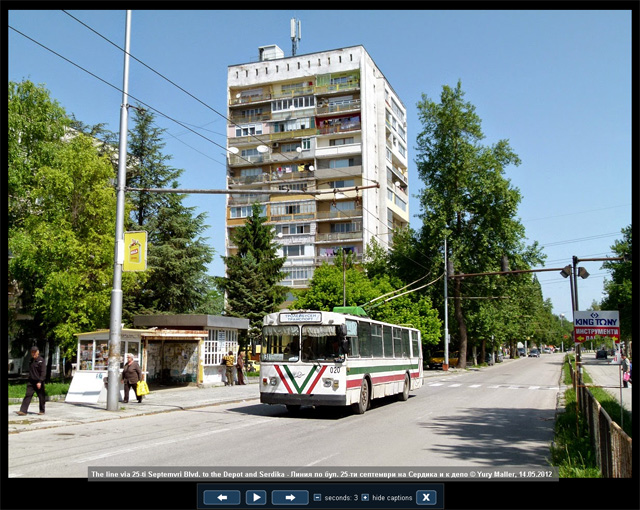
1988 - 01.07.2014



[ as of 2014 ]
City
Founded:
Early XVI century
Population:
90 375 (2012)
All-time maximum population:
109 142 (1985)
Location:
Dobrich
Previously known as Tolbukhin, the city of Dobrich is essentially a collection of high-rise residential developments built around now-dormant large industrial parks. It is the poorest city in Bulgaria, with most populace attracted away by the neighboring seaside city of Varna, country’s premier resort, located 40 km. nearby.
Network Stats
Operator: Troleybusen transport EOOD
System opened:
1988
System closed:
01.07.2014
Overhead length:
45,0 km. (one-way)
All time maximum number of routes:
10
Number of routes when system closed:
5
All time maximum number of passenger vehicles (1989):
56
Number of passenger vehicles when system closed:
21
Number of vehicles required for service (2012):
20
Network map:
2012
Timetable:
2012
In the last years before trolleybus system’s closure the operation was reduced to a publically subsidized service via corridors between high-rise residential developments and dormant industrial parks. All other more lucrative transit corridors were given away to private diesel bus carriers, while trolleybuses provided supplementary service during peak hours only.
Ten trolleybus lines were originally operated. By 2012 eight services were on the books, however, only the Lines 111 and 176 that serve the western and the northern industrial parks respectively operated regularly all day long, and with tolerable intervals. All other services operated Monday to Friday and had only a few journeys each. The Line 131 ran every 60 minutes despite the fact that it served a high-rise development area with no alternative service. The counter-circular Lines 123 and 124 operated with 4 and 12 daily peak hour journeys respectively. The Line 170 had only 4 peak hour journeys. The Line 177 was the only service to operate via the Rusia Blvd. line, nevertheless, it boasted a single morning peak daily departure in one direction only. The Line 199 had 2 nighttime journeys scheduled around intercity trains in and out of the Main Railroad Station, and covered the entire network via a one-way loop; in the last few years of operation it was served with diesel buses. The Line 111 was the only service operating as late as 21:00, while all other services stopped running at the end of the evening peak hour. Only four vehicles operated on weekends, serving the premier Lines 111 and 176, two vehicles each. Conductors were used Monday to Friday only.
Consequently, trolleybuses carried very light loads. Trolleybuses ran almost empty within industrial parks, practically comprising a form of a social subsidy. Interestingly, the timetable adherence was high, so trolleybuses kept a devoted, however modest, patronage.
The Lines 124, 131 and 199 were suspended on 23.06.2013. Five services, the Lines 111, 123, 170, 176 and 177, operated for the last year prior to system’s closure. Out if these services 123, 170 and 177 comprised only 8 peak daily journeys combined. The official closing date was 01.07.2014, however, maintenance of trolleybuses ceased earlier in anticipation of the closure, and trolleybuses stopped running in mid-Spring of 2014, with diesel buses providing service instead.
Rolling Stock
As of 2014 total of
21
vehicles:
ZiU-682V10
: 21 (1987,1988)
Vehicles ever used:
ZiU-682V10
: total 45 (1987,1988)
ZiU-683V01
: total 11 (1989) articulated, retired 2000
In the last years before system’s closure most trolleybuses appeared increasingly rundown. 013 was rebuilt in 2008 for the 20th anniversary of the network into a semi-open air vehicle with wooden seats, with the front and middle doors only. After three years of summer time service-only, it remained unused.
Photo gallery
Last updated:
31-Dec-2014
© 2002 Author: Yury Maller - Usage of material found herein for public display is possible with authors' permission only.
Special thanks:
 AK (Aleksandr) - maps; Kostj Kozlov, AK (Aleksandr), Dissident - photos.
AK (Aleksandr) - maps; Kostj Kozlov, AK (Aleksandr), Dissident - photos.